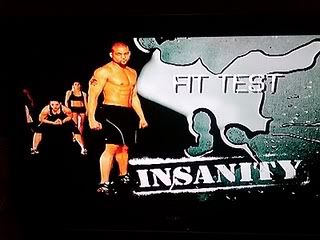INSANITY® and the X
By Steve Edwards
Today we'll discuss Beachbody's new INSANITY program and how to approach it if you've already done P90X. The INSANITY guidebook is written for first-time Beachbody® customers. If you've already completed one or more of our programs, especially P90X, you're going to want to take a different approach. We'll also look at how to schedule INSANITY post-X and how to use it to improve your P90X results.
All of our entry-level programs' diet guidebooks are written assuming weight loss is a primary concern. The P90X diet guidebook is not. Instead, its focus is on athletic performance, because the key to getting results with P90X is to improve your physical fitness as much as possible over the course of the program. While INSANITY is definitely a graduate-level program—meaning you need a fitness base prior to beginning—it is not structured periodizationally the way P90X is. It's shorter and more straightforward. Its results are based more on progressive overload than Muscle Confusion™. Similarly, the diet is based simply on eating clean, then ramping up the calories along with your workouts. Those coming off the X will want to amend the INSANITY diet guidelines or ignore them totally.
The INSANITY diet is very calorically restrictive. It was designed for weight loss, since that's what most of our customers are interested in. If you're coming off P90X or something similar, you should alter the diet to suit your needs, because your body composition will be far more athletic at the beginning. We've left the "additional food" section of the INSANITY diet open-ended for just this reason. However, once you've gone through several rounds of the X or something equivalent, you're generally at a point where you should do your own dietary calculations.
When you look at the X diet, you see a plan that's designed to teach you how to eat for athletics. It varies over time, attempting to follow the changes in your body composition. Once you graduate from the X, there shouldn't be much need for outside diet plans except for variety's sake. You could use the INSANITY diet for this, but you'll want to alter your calories to meet your own goals using what you've already learned. It's almost a certainty that a post-X body will have a composition that requires more calories than what the INSANITY diet recommends.
Keep in mind that no matter what diet you choose, at the highest level of performance you always have to do your own trial and error. There's no one diet that's right for everyone. Nowhere is this as apparent as during athletic endeavors. By making tweaks to our diets, we will always find individual differences in the ways certain foods affect us. No two athletes eat exactly the same way. There are some large-scale brushstrokes that are nutritionally similar, after which what works best becomes more individualized.
Now let's look at how to cycle INSANITY into your Beachbody library. The most common question we get is how INSANITY will affect the muscle mass gained during X. The answer is that if you do it right, INSANITY can improve your muscle mass. This is because of basic physiology, primarily the periodization principle. Once you grasp this, it should be fairly easy to figure out how to schedule INSANITY.
Let's begin with recovery. The time between doing different workout programs becomes very important as your fitness improves. We always recommend a break after our workout programs, but P90X and especially INSANITY require more calculation. These programs are designed to break you down, let you recover, then increase the breakdown and finish with a bang. The goal is to put your body into a growth (sometimes referred to as mastery) phase over the final few weeks of the program. During this phase, results come rapidly, but stay in it too long and you overtrain, which forces your body into a plateau, or worse, a decline. This is why we recommend that your final P90X fit test be done after a week of recovery.
When transitioning from P90X to INSANITY, it's important to consider that you're moving from a mastery phase of one program into an entry phase of another. Sure, INSANITY's entry phase is very hard, but over the course of P90X, your workload capacity has been improving. Because INSANITY doesn't have a true resistance component, its first week can function similarly to the transition/recovery weeks of P90X. Post-X, your body's ability to adapt to hard exercise is greatly increased. This means you can start INSANITY on the heels of P90X, and its first week will function as your recovery week. Even though INSANITY will also break you down in some new areas, your fitter body will adapt quickly to the change.
Conversely, post-INSANITY, you'll want a longer recovery period. This is because you've essentially extended the adaptive and growth phases of P90X for an extra 6 to 8 weeks. No matter how fit you are, your body will always need a break after taking such a pounding. One to 3 weeks of easy to moderate exercise should have you recovered and ready to move into your next round of training, no matter what it is.
Speaking of adaptive and growth phases, we should also address how you may want to shorten the first block (or month) of INSANITY. Similar to the diet phases of P90X, you'll only want to continue in the first block of INSANITY as long as your body is adapting to it. Once it feels "easy," it's time to move into the second block. You'll still want to take the designated INSANITY recovery week because you want to be rested for your next block of training. This will accelerate your time in the adaptive phase of the training block and help you maximize the growth phase.
Finally, we need to discuss how this can improve your muscle mass. The 6 to 8 weeks of INSANITY will have improved various energy systems of your body, increasing its potential for hard training. INSANITY will improve your aerobic and anaerobic capacities. Your VO2/max and anaerobic threshold will both improve, as will your body's glycolytic efficiency, which is your ability to recharge your anaerobic system during intense bouts of exercise. The result is that in your next round of P90X (or any muscle-building program), you'll have more energy to burn at the end of each set. This will result in increased reps per set or more weight per set, both of which lead to increased hypertrophy (muscle growth) if that is your target.
These are the basic principles you should understand about P90X and INSANITY. As with all high-level training programs, there are plenty more variables that can be discussed. Since these are more personal in nature, they should be addressed on the Message Boards, where we can discuss them on a case-by-case basis
If you'd like to ask a question or comment on this newsletter article, click here to add a comment in the newsletter review section or you can email us at mailbag@beachbody.com.
Check out our Fitness Advisor's responses to your comments in Steve Edwards' Mailbag on the Message Boards. If you'd like to receive Steve Edwards' Mailbag by email, click here to subscribe to Steve's Health and Fitness Newsletter. And if you'd like to know more about Steve's views on fitness, nutrition, and outdoor sports, read his blog, The Straight Dope.

By Steve Edwards
Today we'll discuss Beachbody's new INSANITY program and how to approach it if you've already done P90X. The INSANITY guidebook is written for first-time Beachbody® customers. If you've already completed one or more of our programs, especially P90X, you're going to want to take a different approach. We'll also look at how to schedule INSANITY post-X and how to use it to improve your P90X results.
All of our entry-level programs' diet guidebooks are written assuming weight loss is a primary concern. The P90X diet guidebook is not. Instead, its focus is on athletic performance, because the key to getting results with P90X is to improve your physical fitness as much as possible over the course of the program. While INSANITY is definitely a graduate-level program—meaning you need a fitness base prior to beginning—it is not structured periodizationally the way P90X is. It's shorter and more straightforward. Its results are based more on progressive overload than Muscle Confusion™. Similarly, the diet is based simply on eating clean, then ramping up the calories along with your workouts. Those coming off the X will want to amend the INSANITY diet guidelines or ignore them totally.
The INSANITY diet is very calorically restrictive. It was designed for weight loss, since that's what most of our customers are interested in. If you're coming off P90X or something similar, you should alter the diet to suit your needs, because your body composition will be far more athletic at the beginning. We've left the "additional food" section of the INSANITY diet open-ended for just this reason. However, once you've gone through several rounds of the X or something equivalent, you're generally at a point where you should do your own dietary calculations.
When you look at the X diet, you see a plan that's designed to teach you how to eat for athletics. It varies over time, attempting to follow the changes in your body composition. Once you graduate from the X, there shouldn't be much need for outside diet plans except for variety's sake. You could use the INSANITY diet for this, but you'll want to alter your calories to meet your own goals using what you've already learned. It's almost a certainty that a post-X body will have a composition that requires more calories than what the INSANITY diet recommends.
Keep in mind that no matter what diet you choose, at the highest level of performance you always have to do your own trial and error. There's no one diet that's right for everyone. Nowhere is this as apparent as during athletic endeavors. By making tweaks to our diets, we will always find individual differences in the ways certain foods affect us. No two athletes eat exactly the same way. There are some large-scale brushstrokes that are nutritionally similar, after which what works best becomes more individualized.
Now let's look at how to cycle INSANITY into your Beachbody library. The most common question we get is how INSANITY will affect the muscle mass gained during X. The answer is that if you do it right, INSANITY can improve your muscle mass. This is because of basic physiology, primarily the periodization principle. Once you grasp this, it should be fairly easy to figure out how to schedule INSANITY.
Let's begin with recovery. The time between doing different workout programs becomes very important as your fitness improves. We always recommend a break after our workout programs, but P90X and especially INSANITY require more calculation. These programs are designed to break you down, let you recover, then increase the breakdown and finish with a bang. The goal is to put your body into a growth (sometimes referred to as mastery) phase over the final few weeks of the program. During this phase, results come rapidly, but stay in it too long and you overtrain, which forces your body into a plateau, or worse, a decline. This is why we recommend that your final P90X fit test be done after a week of recovery.
When transitioning from P90X to INSANITY, it's important to consider that you're moving from a mastery phase of one program into an entry phase of another. Sure, INSANITY's entry phase is very hard, but over the course of P90X, your workload capacity has been improving. Because INSANITY doesn't have a true resistance component, its first week can function similarly to the transition/recovery weeks of P90X. Post-X, your body's ability to adapt to hard exercise is greatly increased. This means you can start INSANITY on the heels of P90X, and its first week will function as your recovery week. Even though INSANITY will also break you down in some new areas, your fitter body will adapt quickly to the change.
Conversely, post-INSANITY, you'll want a longer recovery period. This is because you've essentially extended the adaptive and growth phases of P90X for an extra 6 to 8 weeks. No matter how fit you are, your body will always need a break after taking such a pounding. One to 3 weeks of easy to moderate exercise should have you recovered and ready to move into your next round of training, no matter what it is.
Speaking of adaptive and growth phases, we should also address how you may want to shorten the first block (or month) of INSANITY. Similar to the diet phases of P90X, you'll only want to continue in the first block of INSANITY as long as your body is adapting to it. Once it feels "easy," it's time to move into the second block. You'll still want to take the designated INSANITY recovery week because you want to be rested for your next block of training. This will accelerate your time in the adaptive phase of the training block and help you maximize the growth phase.
Finally, we need to discuss how this can improve your muscle mass. The 6 to 8 weeks of INSANITY will have improved various energy systems of your body, increasing its potential for hard training. INSANITY will improve your aerobic and anaerobic capacities. Your VO2/max and anaerobic threshold will both improve, as will your body's glycolytic efficiency, which is your ability to recharge your anaerobic system during intense bouts of exercise. The result is that in your next round of P90X (or any muscle-building program), you'll have more energy to burn at the end of each set. This will result in increased reps per set or more weight per set, both of which lead to increased hypertrophy (muscle growth) if that is your target.
These are the basic principles you should understand about P90X and INSANITY. As with all high-level training programs, there are plenty more variables that can be discussed. Since these are more personal in nature, they should be addressed on the Message Boards, where we can discuss them on a case-by-case basis
If you'd like to ask a question or comment on this newsletter article, click here to add a comment in the newsletter review section or you can email us at mailbag@beachbody.com.
Check out our Fitness Advisor's responses to your comments in Steve Edwards' Mailbag on the Message Boards. If you'd like to receive Steve Edwards' Mailbag by email, click here to subscribe to Steve's Health and Fitness Newsletter. And if you'd like to know more about Steve's views on fitness, nutrition, and outdoor sports, read his blog, The Straight Dope.








































